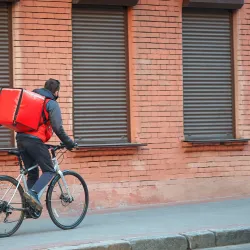Industry Knowledge
Digital Retail Experience: What Do Your Customers Want in 2022?
Published on March 15, 2022
Last Updated on August 24, 2022
The retail industry landscape is constantly evolving, and your customers’ expectations are ever-increasing. In this article, we cover five things your customers want that will help you deliver the best digital retail experience.
- Meet Them in the Metaverse
The lines between the virtual and physical world are blurring as we see more and more people enter the metaverse.
For example, Avatars have become an extension of oneself — so much so, that people are willing to spend thousands of dollars to customize and upgrade their avatars. In a recent survey, 39% of US gamers spent real currency to purchase skins, with some players spending more than $15 per month to customize their characters (1).
This explosive trend creates a unique retail customer experience, giving retailers the opportunity to extend their brand engagement into the metaverse by embracing Direct to Avatar (D2A). D2A allows virtual identities to interact with real-world brands in the metaverse. This includes creating custom outfits, organizing virtual events, or setting up virtual spaces.
Many companies have since included D2A in their retail strategy because it allows them to overcome the biggest challenge of the Direct to Consumer (D2C) approach: logistical and supply chain bottlenecks. D2A removes these friction points while still allowing consumers to enjoy the full experience of interacting with their brand. Nike is one of the largest adopters of the D2A approach. In 2021, they acquired RTFKT to accelerate their digital transformation efforts and extend the Nike digital footprint (2).
Tapping into metaverse shopping provides endless potential for retail companies, allowing you to redefine brand engagement, increase product discovery and online brand conversions, and most importantly, meet your customers where they spend their time.
- Flexibility with Buy Now, Pay Later (BNPL)
Global adoption of BNPL soared in the wake of financial uncertainty in 2020 as changes in spending behavior, product consumption, and payment preferences were made evident. In 2020, more than 1 million Australians canceled their credit cards and sought alternative payment methods (3).
BNPL allows customers to pay for products in installments and choose both their payment amount and their payment terms. In a survey conducted by NerdWallet, 1-in-5 holiday shoppers used BNPL as their payment preference in 2021 (4). Retailers across the globe have even seen accelerated revenue growth by offering BNPL from companies like Affirm, Afterpay, and Klarna.
Macy’s launched BNPL with Klarna in October 2020, and quickly scaled this into Bluemercury and Bloomingdale’s as they immediately saw higher spend per visit and increased acquisition of new, younger shoppers that they hope to convert into loyal customers (5).
Why should retailers consider offering BNPL?
- The flexibility that comes with BNPL gives shoppers more confidence to checkout an item that might have ended up as a cart abandonment.
- Nearly half of consumers said they spend anywhere between 10% - 40% more when they use BNPL as opposed to their credit card (6).
- This form of payment is particularly popular with Gen Z customers, allowing brands to increase the lifetime value of customers as they capture aspirational buyers earlier (6).
- Fast and Free Order Fulfillment
Have you ever shopped for something online but abandoned the cart as soon as you saw that shipping wasn’t free, or that it would take longer than expected to arrive? According to a recent study by Usabilla, 58% of consumers experience this regularly (7).
Today, three-day shipping feels slow. Tomorrow, two-day delivery will also feel slow. Next-day shipping is no longer a luxury but a necessity. As customer expectations continue to increase and more purchases are made online, brands will need to optimize their fulfillment process to win over today’s consumers.
Target is a prime example of a retailer that prioritizes fast and free order fulfillment. They offer free two-day shipping on all orders over $35, free curbside or in-store pick up, and free-same day delivery for all Shipt members (8).
The good news is there are several key players that enable brands to deliver on the promise of fast and free fulfillment so smaller retailers can compete with behemoths like Amazon. Companies like Bringg and Deliverr entered the delivery management software space to help brands elevate the fulfillment experience to meet the consumers’ ever-increasing demands.
- Make Use of the Live Shopping Experience
The live shopping experience first pioneered in the ‘70s by QVC and the Home Shopping Network is back and better than ever. Live shopping took off in China back in 2016, and it is estimated that sales from live shopping will top $423 billion this year (9).
Live shopping combines elements of online shopping and live video streaming, allowing companies to bring in-store experiences online. Rather than reading product descriptions, customers can now join live shopping videos and directly ask questions about the products they’re interested in.
When global operations and travel slowed tremendously at the start of 2020, brands were looking for new ways to engage with their customers. As a result, several brands quickly took advantage of the live shopping trend. In 2020 alone, live shopping generated $5.6 billion in sales in the US and is estimated to rise to more than $25 billion by the end of 2023 (10).
Shoe retailer, Aldo, is a great live shopping success story as it recorded a 308% engagement rate and registered 17,000 page views on its website in the first five days following a live shopping event in 2021 (11).
Why should you consider live shopping as part of your retail management strategy in 2022?
- Brands are acquiring more Gen Z shoppers and reports have shown younger audiences growing more than 20% (9).
- Conversion rates are reported as high as 40% (10).
- It’s proven to be a more sustainable way of selling as live shoppers are 40% less likely to return an item bought through live shopping (12).
- Embracing Mobile
More than half of the world’s website visits come from mobile devices, accounting for more than $359 billion in sales last year. This means that consumers are shopping online via mobile devices or apps. With more time being spent on mobile devices, brands need to seize this opportunity to keep customers interested (13).
Mobile is just another touchpoint in the overall retail customer experience and today’s customer is looking for a way to move easily between online and in-store. At NRF’s Big Show in January this year, Best Buy’s CEO, Corie Barry, stressed the importance of stitching every touchpoint together and said that “customers expect this frictionless experience no matter how they touch your organization” (14).
Sephora is considered a leader in the mobile-friendly space. Sephora offers unique features in their mobile app including Virtual Artist that allows customers to virtually try their products, beauty advisor recommendations, personalized alerts, and beauty guides to help their shoppers find the right product (15).
With mobile, the possibilities are endless. Retailers who want to remain relevant should consider going mobile, otherwise they run the risk of getting left out by their competitors.
It’s all about Ridiculously Good Digital Retail Experience
Customer expectations are higher than ever and it’s important to deliver on your customers’ increasing demands. If you’d like to learn more about how TaskUs can help you deliver on what your customers want in 2022 and beyond, reach out to our team directly here.
References

Bailey Boyd
VP, Retail and eCommerce
Bailey currently serves as Vice President of Business Development for the Global Retail & eCommerce Industry at TaskUs. She started her career at IBM where she specialized in industry solutions and global business services for the Retail & Consumer Products space. Driven by a mission to empower businesses to better serve their customers, Bailey is best known for helping hyper-growth D2C and eCommerce brands to scale exceptional experiences. When she isn’t working, you will most likely find Bailey on walks with her Golden Retriever, Timber!
Related Expertise
Related Insights
We exist to empower people to deliver Ridiculously Good innovation to the world’s best companies.
Services








